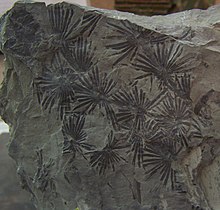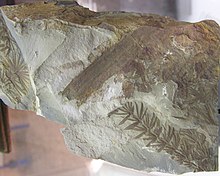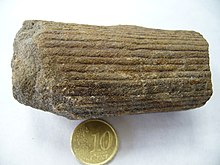Calamitaceae
| Calamitaceae | |
|---|---|

| |
| Annularia stellata | |
| Scientific classification | |
| Kingdom: | Plantae |
| Clade: | Tracheophytes |
| Division: | Polypodiophyta |
| Class: | Polypodiopsida |
| Subclass: | Equisetidae |
| Order: | Equisetales |
| Family: | †Calamitaceae Unger, 1840[citation needed] |
| Genera | |
|
See text | |
Calamitaceae is an extinct family of plants related to the modern horsetails.[1] Some members of this family attained tree-like stature during the Carboniferous Period (around 360 to 300 million years ago) and in Permian Period, reaching heights of up to 20 meters. The family takes its name from its principal genus Calamites.
Because some proposed species are based on partial fossil records, it is not clear if these are merely different parts of the same type.
Proposed genera and species of Calamitaceae[]

- Annularia.
- A. stellata.
- Arthropitys.
- (or incorrectly Asterophyllum).
- .
- Calamites.
- C. carinatus.
- C. suckowi.
- C. undulatus.
- .
- .
- C. binneyana.
- .
- .
- .
References[]
- ^ Elgorriaga, A.; Escapa, I.H.; Rothwell, G.W.; Tomescu, A.M.F.; Cúneo, N.R. (2018). "Origin of Equisetum: Evolution of horsetails (Equisetales) within the major euphyllophyte clade Sphenopsida". American Journal of Botany. 105 (8): 1286–1303. doi:10.1002/ajb2.1125. PMID 30025163.
External links[]
Categories:
- Equisetales
- Carboniferous plants
- Prehistoric plant families
- Carboniferous first appearances
- Carboniferous extinctions
- Paleobotany stubs

